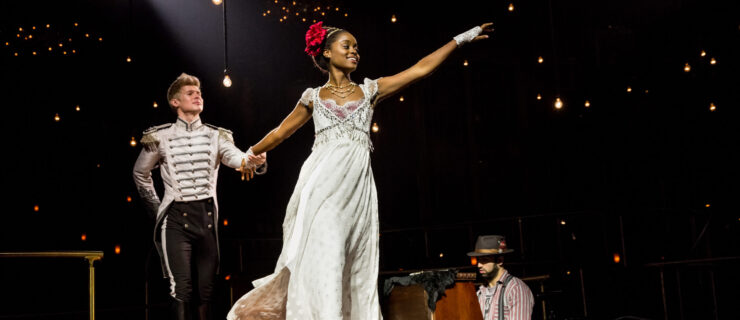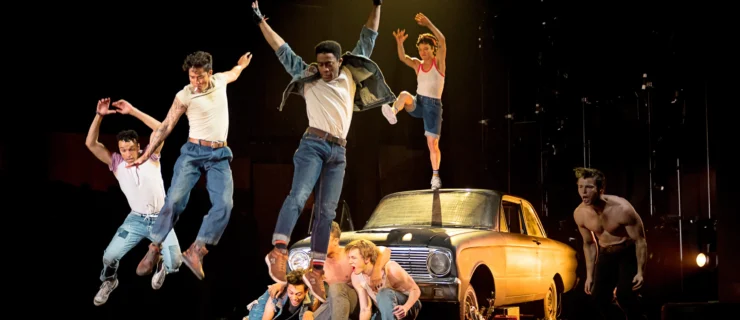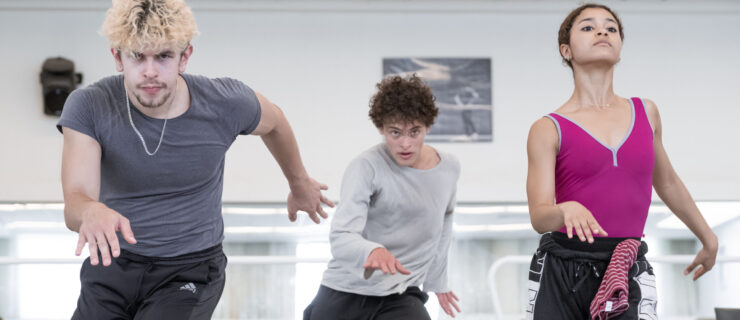Reviews
Limón Dance Company
Harkness Dance Festival • 92nd Street Y • March 5–7, 2010 • Reviewed by Gus Solomons jr.
The Harkness Dance Festival moved in-house this year to the close quarters of the Y’s Buttenweiser Hall. Limited seating meant sold-out shows, and the intimacy of the space made watching dances there a more personal experience. The second week of the festival, which marked the Y’s 75th year as a home for dance, featured the Limón Company in short dances and excerpts by José Limón and choreographers associated with his troupe: Daniel Nagrin, Donald McKayle, and Anna Sokolow.
Beautifully reconstructed by legendary Limón dancer Sarah Stackhouse, La Malinche (1947) clearly resembles Graham’s El Penitente (1940). Like Graham’s trio, Limón’s depicts street performers, here re-enacting a Mexican legend about an Indian princess (Kathryn Alter), who helps El Conquistador (Jonathan Fredrickson) conquer the natives, then returns after her death to liberate those he enslaved, represented by El Indio (Daniel Fetecua Soto).
Raphaël Boumaïla’s interpretation of Daniel Nagrin’s Dance in the Sun (1951) is more lyrical than Nagrin’s, whose dancing was dynamically abrupt. Boumaïla ebulliently leaps and darts, basking in the sun to an original piano score by Ralph Gilbert that closely matches the movement’s phrasing.
Two sections from artistic mentor Donald McKayle’s 1997 Heartbeats—“He Mele Aloha” and “Johnny Has Gone for a Soldier”— demonstrate McKayle’s assertive dancing for men and his more overtly emotional, female side, respectively. His classic Rainbow ’Round My Shoulder (1959) more deeply embodies these qualities. But fearless attack into deep lunges and jumps in the first part—danced by Boumaïla, Dante Puleio, Durell R. Comedy, and Ashley Lindsey—and in the second part, Kristin Foote’s restrained grief that bursts into dignified rage, make the choreography entirely convincing.
Anna Sokolow’s seminal Rooms (1955), which innovated setting modern dance to progressive jazz, retains its power in two sections staged by Sokolow alumnus Jim May. Wiry and muscular Puleio spars and claps his hands angrily as a tightly wound, wannabe prizefighter in “Going.” Then, in “Desire,” an ode to isolation, he joins five others: six lonely people, seated on folding chairs, restlessly shuffling their feet and rolling on the floor, close enough to kiss but never connecting.
Finally, a major revival of Limón’s There Is a Time (1956) reminded us how powerful interpretive modern dance can be even now. A dozen sections illustrate the text from Ecclesiastes—a time to be born, to die, to kill, to heal, to laugh…. Yet Limón’s poetic choices of theatrically eloquent movement transcend their literalism.
The intimacy of the stage—lit masterfully with limited instruments by David Ferri—made this by far the most emotionally pungent version I can recall. At close range, movement and characters took on fresh urgency, and the splendid troupe danced with uniform technical élan and spiritual eloquence.
Toronto Dance Theatre
Fleck Dance Theatre • Harbourfront Centre, Toronto, Canada • February 16–20, 2010
Reviewed by Michael Crabb
Choreographers’ inspirations sometimes get the better of them, which appears to be what’s happened to TDT’s artistic director Christopher House. Pteros Tactics, his latest work, was spurred by Canadian scholar Anne Carson’s disquisition on the ancient Greek concept of “eros,” the sensual longing part of what we mean by the grab-all word “love.” However, what makes intellectual sense in Carson’s essay “Eros the Bittersweet” does not necessarily translate into the more visceral language of dance.
House, of course, is not really attempting a translation. Instead, he takes certain ideas from Carson and runs with them. Unfortunately he does not get very far.
As explained in an obtuse program note by Belgian dramaturge Guy Cools, House picked up on the idea of desire as an act of reaching out to fill a sense of incompleteness. He was also intrigued by the theory that desire can only exist if there is some third entity potentially preventing its consummation.
House moves this up another notch by conceiving eros (or Pteros) as a metaphor for the creative act itself in a triangulation of choreographer, performers, and audience. This neatly ties in with House’s continuing interest in the performer/audience relationship.
So much for theory; the actual dance begins unpromisingly. TDT’s 10 performers wander out one by one and introduce themselves, supplementing their names with teasing comments or inconsequential snippets of personal information.
Despite a number of ensemble passages, the choreographic meat of Pteros Tactics is—predictably, given the subject—delivered in duets of varying gender combinations. The relationships are fraught—plenty of bitter and little sweet—and range from flirtatious to provocative to almost violently hostile.
Dancers collapse like a line of dominoes, and a symbolic ballgame spills into the audience. House also draws on a metaphor from the Greek poet Sappho: “Eros once again limbloosener whirls me sweetbitter.” Loose limbs, jutting and whirling in sometimes frenetic bursts of movement, are predominant choreographic features of Pteros Tactics. They are not enough to make it absorbing or coherent. Oddly for a dance about love, it ends up being an arid 60 minutes.
Photo of the Limon Company by Meems, courtesy Limon Dance Company




